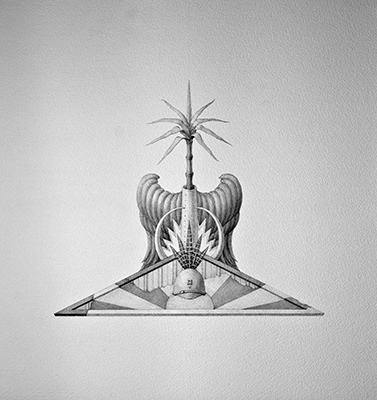The word “symbol” has its roots in the Greek symbolon, which originally meant to throw, or bind, something together. Can we look at history as symbolic in this sense, as a synthesis and violent amalgamation of events and disparate influences, which together form the image and imagination of the present and the past? The symbolic, used in this sense of “binding together,” stands for power, for domination, and for the subjugation of disparate peoples and elements under a single rule. The symbols known as “coats of arms” are such symbols par excellence.
The piece Arms by Chia-En Jao is about the making of both symbols and Taiwanese history. Employing the symbolic language—the “genre” —typically used on such emblems, he designed thirty coats of arms. Each coat of arms is composed of a multitude of elements that have come to signify events, materials, or structures that are deeply ingrained into the history and cultural memory of Taiwan.
The coat of arms pictured here shows the rising sun, representing the imperial Japanese dream of “uniting” Asia. In the late nineteenth century, Japan took possession of Taiwan from the defeated Qing Dynasty, which had ruled the island since the seventeenth century. The sun on the coat of arms rises above the South Pacific Islands, and the (broken) shape of Taiwan’s Yushan mountain is visible. Portions of the triangle are filled in with galvanized steel plates, which are commonly used to build factories in Taiwan. Above the red sun is an American military helmet, representing US hegemony in Taiwan under the KMT, after Japan’s defeat. On top of the helmet are feathers of a Taiwanese Mikado pheasant, while in the background there is an unidentified inferno against the backdrop of black eagle wings, the iconic imperial symbol. In the center of the image is an upright cannon in which a sugar cane grows—the very first commodity cultivated in Taiwan, which aroused imperial interest and led to the waves of colonization that have defined Taiwanese history—and continue to define it today.
Chia-En Jao, born 1976 in Taiwan, lives and works in Taipei

